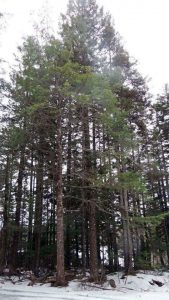
Hemlock was a common Witness Tree in historical documents for the Kouchibouguac area, but is not common on that landscape today
I attended an earlier version of this presentation at the Nature Nova Scotia 2016 Conference & AGM held at Acadia University in late May. Donna put together a fascinating perspective that covered time spans over the full history of the earth (4.65 bya), the last 350 years, the last 60 years, and then looked into the future. She talked about her research in the area of Kouchibouguac Park in New Brunswick in which she used Witness Trees in land ownership documents to indicate the composition of forests in the early days of European settlement. She compared that state to the composition today and explored the factors that have led to the very different forests we see today in NB and NS, and the ongoing challenges.
It wasn’t just our direct use of trees that changed our forests. Exotic earthworms, white tailed deer, invasive species, acid rain and several other factors were and are involved. Donna presented an optimistic view of how we could adapt to ongoing climate changes but the options she talked about are not, by and large, ones we are currently pursuing.
The presentation was spiced with a wonderful sense of humour, but the messages are serious ones. The Blomidon Field Naturalists welcome the public. I am sure that anyone with an interest in the state of our forests would come away with some new perspectives.
In her May presentation, Donna mentioned an upcoming meeting at which experts would decide on whether we are actually entering a new geological epoch when assessed by the same type of criteria by which such transitions are identified in the geological record. I checked it out and indeed, Donna was not exaggerating our influence on our Earth: “Humanity’s impact on the Earth is now so profound that a new geological epoch – the Anthropocene – needs to be declared, according to an official expert group who presented the recommendation to the International Geological Congress in Cape Town on Monday [Aug 29, 2016].” View report in The Guardian.
——
Witness Trees: When the settlers documented their lands, they put marks on larger trees to identify corners, and identified these “Witness Trees” on charts as fir, pine, elm etc.
